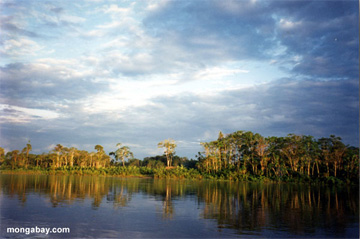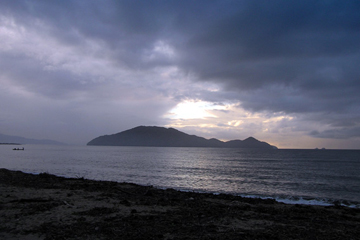Today marks the 10th birthday of mongabay.com.
Originally launched as an online version of a manuscript about tropical rainforests (A Place Out of Time), the site has grown over the years to encompass a wide range of topics. Along the way I’ve met some remarkable people, experienced some incredible adventures, and visited some unforgettable places.
The site has also grown in other ways — this month mongabay added its first employee besides myself: writer Jeremy Hance.
The origin of mongabay
 Rio Napo in Peru, down-river from the oil spill in Ecuador. A history of mongabay
|
The seeds for mongabay were sewn by two places: the Ecuadorean Amazon and Malaysian Borneo. While I was blessed with the good fortune to travel to many places starting from a young age (thanks to a travel agent mother and a father who racked up a lot of airline miles), these two places left a lasting impression, not because of the time I spent in their majestic forests but because the fate that befell them after I departed. In the case of the Ecuadorean Amazon, it was an oil spill; in the case of Sabah (Malaysia), it was logging. Both broke my heart.
The following, which serves as the preface of A Place Out of Time and was written in 1999, details my experience in Borneo.
-
Lingering beside a small stream in the Malaysian rainforest of Sabah, on the island of Borneo, I watch the water move swiftly over worn, round stones. The pace of the flow quickens as the stream cascades over a short waterfall into a clear pool. Vibrantly colored butterflies in shades of yellow, orange, and green flirt with columns of light that penetrate the dense canopy. The raucous calls of hornbills challenge the melodic drone of cicadas. Though the forest is never silent or still, it brings a deep sense of calm.
I sit with my feet in the cool water, picking over my clothes in search of leaf leeches, who seek a feeding opportunity in every crease of material. As I remove these brightly hued creatures, I am content to watch a lone male orangutan silently make his way through the branches above the stream. The idyllic setting and the company of my red-bearded simian companion provide the perfect end to my half-day trek.
Such wildlands provide me with an escape from the daily rigors and chaos of my profession, and I have come to greatly appreciate places of natural wonder.
– – –
 Dipterocarp in Sumatra Dipterocarp in Sumatra
The origin of the name “mongabay” Mongabay is derived from an anglicized spelling and pronunciation of an island off Madagascar, Nosy Mangabe. Nosy Mangabe is best known as a preserve for the Aye-aye, a rare and unusual lemur famous for its bizarre appearance. In selecting mongabay, I wanted to have a totally unique name for the site so I could track references in the early days of the site. |
I have long had a fascination with the natural world and its creatures, but the idea for this book arose out of deep sadness. Eight weeks after leaving the tract of Malaysian rainforest that had filled me with happiness, I learned the forest was gone, logged for wood chips to supply a paper-pulp plant. This place of wonder and beauty was lost forever. The orangutan, the hornbills, the butterflies, and even the leeches would now have to make do in their dramatically changed environment.
Despite my few years in the forest, this was not the first time I had lost such a special place, nor would it be the last.
These personal losses have long troubled me, but the loss of that small section of forest in Borneo created the urgency to act upon a thought that had been nagging me. While environmental losses and degradation of the rainforests have yet to reach the point of collapse, the continuing disappearance of wildlands and the loss of their species are disheartening. I feel sorrow for those who have not yet had the privilege of experiencing the magnificence of these places, and I try to picture how—should biodiversity losses continue to mount—I will explain to my grandchildren why these places that I enjoyed in my youth no longer exist.
The lesson of A Place Out of Time is that we may not have to accept this future. A lot can still be done. Using our intelligence and ingenuity, the human species can preserve biodiversity and unique places for future generations, without compromising the quality of life for present populations.
I hope this description provides some background on my motivation to launch mongabay. It’s been a long, but interesting journey, and I’m looking forward to the next ten years of running mongabay.
Press highlights
- The San Francisco Chronicle, July 2006 profile of the site.
- TreeHugger.com, August 2006 interview.
- The Wall Street Journal Online, September 2006 mention.
- Google Blog, October 2007 profile.
- Time.com, In April 2008, Time.com selected mongabay.com among its 15 top climate and environment web sites.
- Voice of America, In November 2008, VOA did a radio segment on mongabay.com.
Other background







